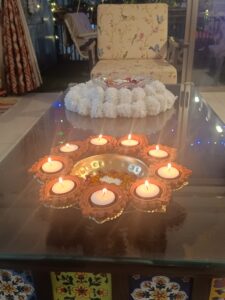How to Use Colour to Enhance Mood and Well-Being
Hello, lovely readers! Have you ever walked into a room and immediately felt a certain way? Maybe a sense of calm washed over you, or you felt energized and ready to take on the world. Believe it or not, the colours around us can significantly impact our mood, productivity, and overall well-being. Today, let’s try to explore the fascinating world of colour psychology and learn how to use it to create the perfect ambience in your home.
Why Colour Matters
Colour isn’t just about aesthetics; it’s a powerful tool influencing our emotions and behaviour. From the calming blue of the ocean to the invigorating red of a sunset, colours affect us subconsciously. In-home decor, the right colours can transform a space, making it feel cosy, vibrant, or serene. Whether you’re redecorating a single room or your entire home, understanding the psychology of colour can help you create environments that support your lifestyle and personal well-being.
The Psychology of Different Colours
Let’s explore the effects of different colours and how you can use them effectively in your home:
1. Blue: The Colour of Calm and Tranquility
Blue is often associated with calmness, serenity, and stability. It’s the colour of the sky and the ocean, bringing a sense of peace and relaxation. Blue is an excellent choice for bedrooms and bathrooms, where you want to create a soothing atmosphere. It can also enhance concentration, making it a good option for a home office. Lighter shades of blue can make a space feel more open and airy, while deeper blues add a sense of elegance and sophistication.
2. Red: The Colour of Energy and Passion
Red is a powerful, attention-grabbing colour that evokes feelings of passion, excitement, and energy. It can stimulate appetite, which is why it’s often used in dining rooms and kitchens. However, red can be overwhelming if overused, so it’s best to incorporate it as an accent colour rather than the main hue. Red throw pillows, artwork, or a feature wall can add a vibrant touch without being too overpowering.
3. Yellow: The Colour of Happiness and Optimism
Yellow is the colour of sunshine, associated with joy, warmth, and positivity. It’s a great colour for spaces where you want to feel energized and cheerful, like kitchens or playrooms. Yellow can also stimulate mental activity, making it a good choice for a study area. However, be mindful of the shade you choose—too bright can be overstimulating, while softer yellows are more soothing and welcoming.
4. Green: The Colour of Balance and Renewal
Green represents nature, growth, and balance. It’s a refreshing colour that brings a sense of renewal and tranquillity, making it perfect for living rooms and bedrooms. Green is also known to reduce stress and create a sense of harmony, which is why it’s often used in places like spas. Combining different shades of green can mimic the diversity of nature, adding depth and interest to your decor.
5. Purple: The Colour of Luxury and Creativity
Purple is associated with luxury, royalty, and creativity. Lighter shades like lavender can have a calming effect similar to blue, making them suitable for bedrooms and relaxation areas. Richer shades like deep purple or violet add a sense of opulence and can be used to create dramatic focal points in a living room or study. Purple is also thought to stimulate creativity, making it an excellent choice for artistic spaces.
6. Orange: The Colour of Enthusiasm and Warmth
Orange is a warm, inviting colour that combines the energy of red and the happiness of yellow. It’s known to boost enthusiasm and creativity, making it a great choice for spaces where people gather, like living rooms or social areas. Orange is also a welcoming colour for entryways. As with red, it’s best used as an accent colour to avoid feeling too intense.
7. White: The Colour of Purity and Simplicity
White represents purity, cleanliness, and simplicity. It’s often used to create a sense of space and openness, making it a popular choice for modern, minimalist designs. White can make a room feel fresh and airy, but it can also feel cold and sterile if not balanced with other elements like texture and colour accents. Incorporating warm lighting and natural materials can help soften the starkness of white.
8. Black: The Colour of Sophistication and Drama
Black is associated with power, elegance, and sophistication. It’s a bold choice that can add drama and depth to a space. When used thoughtfully, black can make other colours pop and create a striking contrast. However, too much black can make a room feel dark and overwhelming, so it’s best used sparingly—perhaps in furniture, accents, or as a grounding element in design.
9. Grey: The Colour of Neutrality and Sophistication
Grey is a versatile colour that can be both soothing and sophisticated. It serves as a neutral backdrop, allowing other colours to stand out. Grey’s calming nature makes it suitable for bedrooms, living rooms, and offices. Different shades of grey can create various moods—light grey is airy and soft, while dark grey adds drama and cosiness.

Tips for Choosing the Right Colours for Your Space
1. Consider the Room’s Purpose:
Think about how you want to feel in the space. Do you want a relaxing bedroom or an energetic kitchen? Choose colours that align with the mood you want to create.
2. Test Before You Commit:
Before painting a whole room, try swatches of different colours on the wall and observe how they look at different times of the day. Lighting can significantly affect how colours appear.
3. Use the 60-30-10 Rule:
This is a classic interior design rule that suggests using a dominant colour for 60% of the room, a secondary colour for 30%, and an accent colour for the remaining 10%. This creates a balanced and cohesive look.
4. Don’t Be Afraid to Experiment:
Colour is a personal choice, and what matters most is that it makes you feel good. Mix and match colours to find combinations that resonate with you.
5. Incorporate Natural Elements:
Colours inspired by nature, like greens, blues, and earthy tones, can bring a sense of tranquillity and connection to the natural world. Adding plants, wooden furniture, or natural fibres can enhance this effect.
Final Thoughts
Choosing the right colours for your home isn’t just about aesthetics; it’s about creating an environment that enhances your well-being and suits your personality. By understanding the psychology of colour, you can make intentional choices that support your lifestyle, making your home a true reflection of who you are. So, the next time you’re redecorating, think beyond what looks good—consider how the colours make you feel.
What colours do you find most appealing in your home? Have you noticed how certain colours affect your mood? I’d love to hear your thoughts and experiences in the comments!
Until next time, may your home be filled with colours that bring you joy and peace. 🎨
This post is part of the Blogchatter Half Marathon.
Neerja Bhatnagar
Feel free to connect with me on social media if you’d like to stay updated on more content like this!
Instagram | Facebook | YouTube |Twitter |Podcast |
I have written 3 solo books and 3 anthologies. You can buy my books on Amazon. If you are on Kindle Unlimited, you can read them for free. Pls, do check and share your reviews.





Colour has a lot of psychological impact
.But ultimately we need to like the colour and feel happy and thats why many people choose different colours.This was a very interesting post.
Yes Amrita. These are based on studies but as each one of us is unique and have unique choices, ultimately it’s the feeling which finalized our colour choices. Thanks for stopping by.